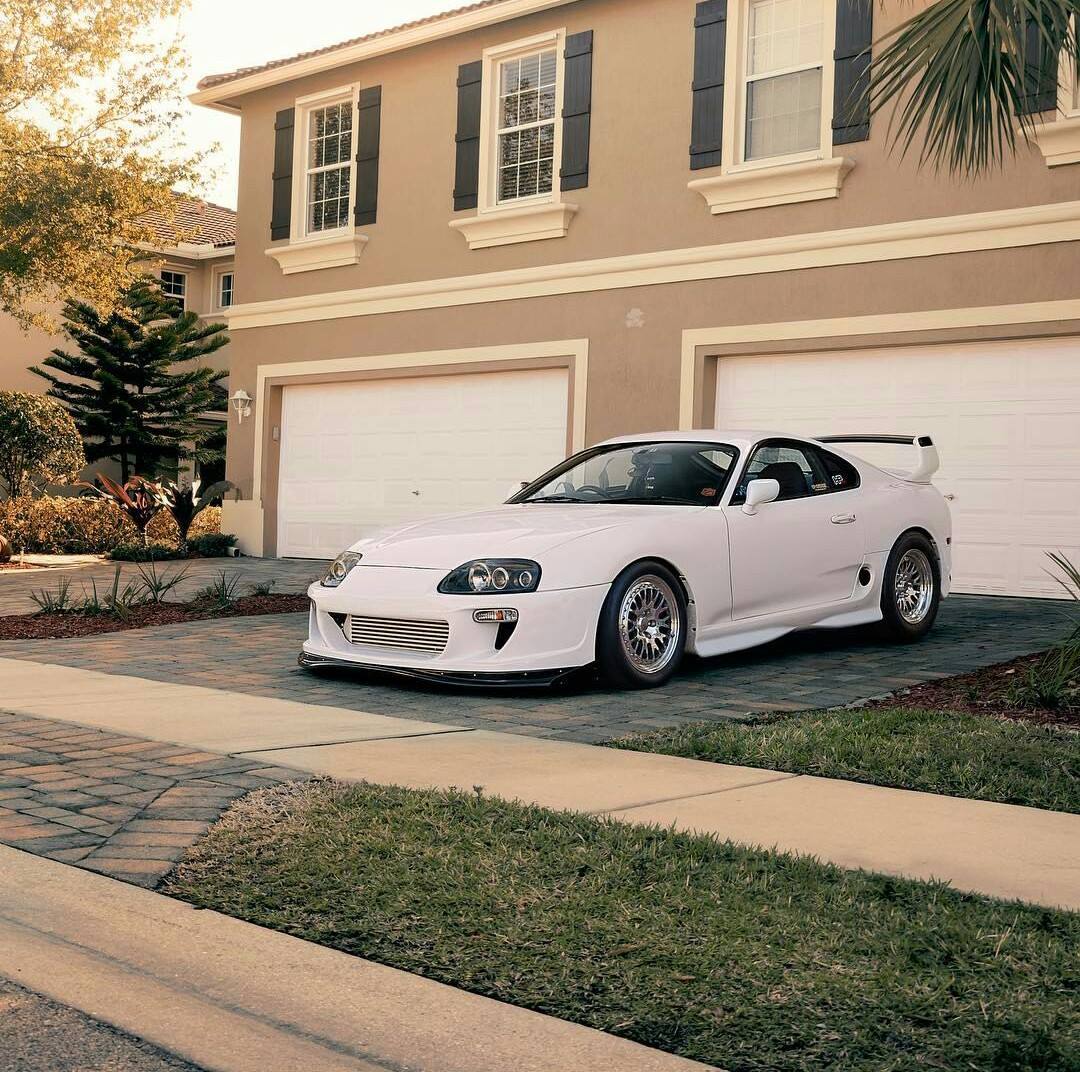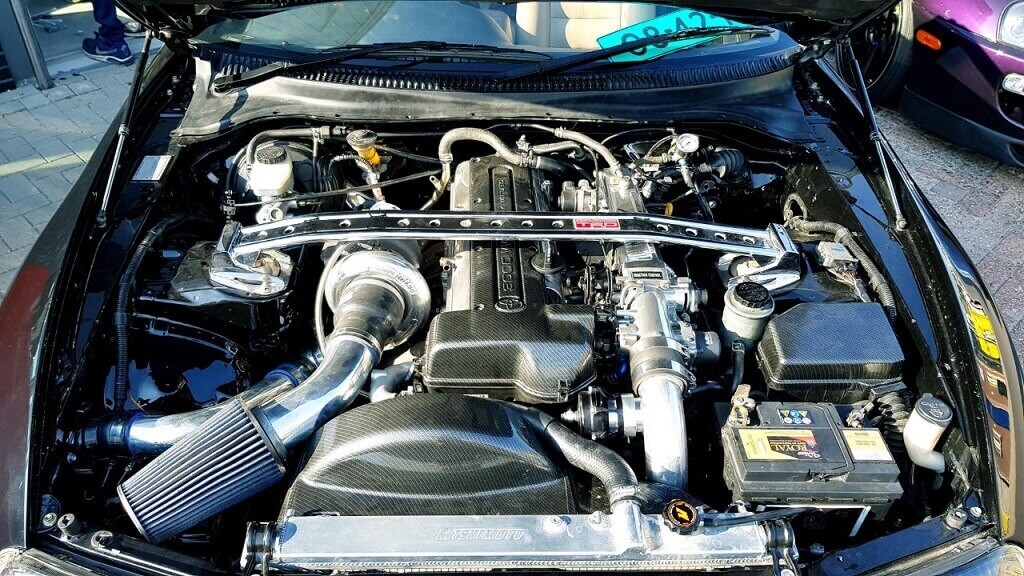 JDM Importing Guide
JDM Importing Guide
The Beginners Guide to Importing from Japan. A must-read before importing JDM. Your FREE guide contains industry tips to getting the best deal on your JDM Import and is now available for download directly. Download Your Guide Over 7,000 copies Downloaded! We respect your Privacy. |
|
|
|
|
|
|
|
|

The JDM Toyota Supra MKIVWritten by Nicholas Williams
BasicsAttractive curves and a long wheelbase, although enticing, do little to prepare an observer for what lies beneath the hood of the MKIV Supra. A complete redesign from the previous generation, Toyota designers looked to the then fastest street-legal production car in the world for a muse – the Ferrari F40. Modeled as a Ferrari fighter from day one the MKIV Toyota Supra lived up to the promise its name made to “go beyond”. Designated the JZA8x platform the new Supra measured up as follows:
Despite its well equipped nature the MKIV Supra still managed to weigh in at less than both the Nissan R33 and R34 Skyline GTRs as well as the Mitsubishi 3000GT VR4. Also, despite an overall larger size the Supra weighs approximately the same as the smaller Nissan Fairlady Z.
DesignBuilt at the Motomachi Plan in Toyota City, Japan great care was taken to ensure that all of the aspects of the new generation were in line with that of a true sports car. Weighing in at 200 lbs less than the MKIII the new Supra still managed to squeeze in a full range of updated safety and performance features as well as a drag coefficient of just 0.33. These enhancements included dual airbags along with traction control as well as larger brakes, larger wheels, larger tires and a second turbo. Weight savings were attained through race bred means such as dished out head bolts, a plastic gas tank and lid, gas injected rear spoiler, single pipe exhaust, hollow carpet fibers, and a magnesium steering wheel. Additionally, aluminum construction was heavily integrated into the vehicle including such components as the hood, front cross member, suspension upper A-arms, oil transmission pans, and targa top on certain models.
Drivetrain2JZ-GE
2JZ-GTE
Export vs JDM Engine ComparisonFor the North American and European markets official power output was raised to 320 horsepower at the same 5600 RPM. Mechanically, the two versions differed as follows: Japan
North America & Europe
* It is possible to replace the ceramic shaft of the CT12B with the harder wearing steel shaft of the CT20A Due to their robust nature and higher end capabilities the stock turbochargers are much less likely to be replaced in mid-power builds than in other engines. However, the impressive OEM build quality doesn’t end there as both the crankshaft and connecting rods come forged from the factory (although the pistons are cast.) It is this commitment to quality that have raised the 2JZ-GTE to the legendary status it has today, boasting numerous examples of quadruple digit horsepower (yes – that’s 1000 hp) on completely stock internals. For comparisons sake, the Bugatti Veyron 16.4 is currently the most powerful street-legal full production car in the world, retailing at approximately $1.5 million USD. The Veyron uses an 8.0 L quad-turbocharged W16 engine to produce its maximum out of 1001 horsepower. It is no surprise then that in the tuning market this engine is considered the main competition to Nissan’s RB26DETT found in the R32 Skyline. The sequential structure of the 2JZ-GTE’s twin turbos is part of the engineered beauty of the MKIV Supra. Traditional parallel structured twin turbos do nothing to compensate for the lag created by adding not one but two turbos onto a naturally aspirated power plant. By running sequential turbos the MKIV Supra can produce power earlier and with more linearity than a similar parallel structure. It is easiest to conceptualize this by walking through the path of exhaust gases as engine demand increases. As power increases from idle all of the exhaust gases flow through the turbine of the first turbo. This creates enhanced power by as early as 1800 RPM and greatly reduces ‘turbo lag’. As demand increases towards 4000 RPM some exhaust begins to split from the first turbo towards the turbine of the second turbo. At this stage the second turbo enters a ‘pre-spool’ stage as it the blades begin to spin but do not add any additional power. When demand hits 4500 RPM exhaust begins to fully divide into an even flow between the two turbos as they both approach full spool. However, outside of the positive aspects of a sequential setup they are not without draw backs. Principally the systems in general are more complicated and less familiar than parallel setups leaving tuners less capable of producing larger horsepower numbers. In essence, if you are only interested in big output for the drag strip then single or parallel turbo setups are for you. However, the linear power delivery of a sequential setup is a little slice of heaven for autocross and other road racing connoisseurs.
TransmissionThe changes continued on for the MKIV Supra as the 2JZ-GTE models saw new 6 speed Getrag/Toyota transmissions (V160). The 2JZ-GE models meanwhile were only able to acquire a 5 speed Toyota transmission (W58). The gear rations for these two models are as follows: 6 Speed Manual (V160)
5 Speed Manual (W58)
On the automatic front, both models were available with the same ‘manumatic’ 4 speed Toyota transmissions (A341E). Some reports note that the A341E suffered similar issues to other ‘sport shifting’ automatics. These include problems in the reverse gear and a lack of fluid shifting through the positive gears. In reality, however, rather than problems these are more closely related to simple inherent differences between the clutch of a manual transmission and the torque converter of an automatic transmission.
Foot WorkWith all of that power high performance breaking was a necessity. The 2JZ-GTE models took advantage of large 4-piston brake calipers on the front and 2-piston calipers for the rear. Mounted over these were 17” 5-spoke aluminum alloy wheels wrapped in 235/45/17 tires on the front and 255/40/17 tires for the rear. The 2JZ-GE model had to do with smaller 2-piston calipers for the front and a single piston caliper for the rear. Similarly, the 5-spoke aluminum alloy wheels were downsized to 16” with 225/50/16 for the front and 245/50/16 for the rears. Handling was well tuned due at least in part to good weight distribution. The 2JZ-GE had 51% of its weight up front and 49% to the rear whereas the 2JZ-GTE 53% of its weight up front and 47% to the rear. In 1994 the 2JZ-GTE MKIV Supra managed a remarkable skidpad rating of 0.98 lateral G's, an amazing feet considering its overall weight. Additionally in 1994, it recorded a 70-0 braking distance of 149 feet, the best braking performance of any production car tested in 1997 by Car and Driver magazine. This was attainable through a 4 sensor, 4 channel track tuned ABS system with yaw control. The system integrated sensors into each caliper and controlled the brakes individually based on the angle, speed, and pitch.
Closing
All in all, the MKIV Supra was miles ahead of time from both a technical and performance stand point. Few production cars today come anywhere near the performance/price ratio that the 2JZ-GTE Supra hit so many years ago. It is no wonder then that, until now, fervent demand has kept the limited supply of USDM spec at such a premium. The first production months of the MKIV Supra creeping ever closer promise to breath new life into the domestic Supra scene. Power, performance, and style are difficult to combine so deftly as managed by the MKIV Supra. Combining this with a price well under $20,000 and we find a match made in motoring heaven. Article Sources
|
||||||||||||||||||||||||||||||







